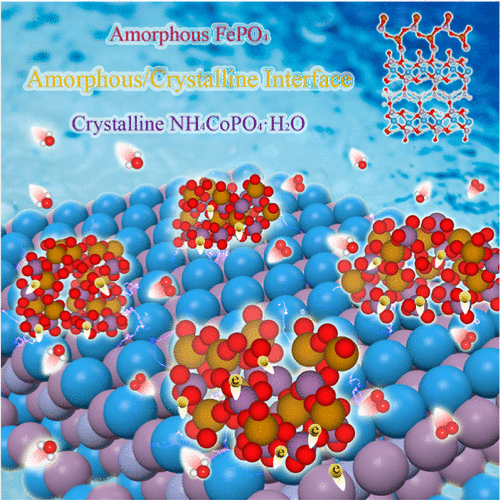
近日,课题组博士生张兴恒论文“Strong Electron Interaction at the Amorphous/Crystalline Interface Enables Advanced Oxygen Evolution Reaction”被ACS Sustainable Chemistry & Engineering(2023年中科院SCI期刊一区TOP期刊,IF=8.4)接收!
Abstract
Incorporating amorphous and crystalline components is undoubtedly a strategy to learn from each other’s strengths and complement each other’s weaknesses for advanced electrocatalysts. Here, an efficient and stable oxygen evolution reaction (OER) catalyst with an amorphous/crystalline interface is reported. Specifically, a rapid coprecipitation approach is proposed to load amorphous FePO4 nanoparticles onto crystalline NH4CoPO4·H2O nanosheets, resulting in a fascinating amorphous/crystalline interface. The prominent coupled effect between FePO4 and NH4CoPO4·H2O is afforded by the interfacial phosphates, which build efficient channels to transfer electrons from Co to Fe. Besides the unique electronic structure, the coupled amorphous/crystalline hybrid facilitates the formation of highly active Co intermediates and accelerates the reaction kinetics and charge transport. Detailed electrochemical characterization reveals that this advantageous interface structure results in a notable decrease in the overpotential of the OER compared to materials with an amorphous phase or crystalline phase alone. The FePO4/NH4CoPO4·H2O hybrid exhibits a small overpotential of only 230 mV to achieve a current density of 10 mA cm–2 in 1 M KOH and 220 mV at 1 mA cm–2 in 0.1 M phosphate-buffered solution (PBS), which are much lower than the corresponding values of the pristine ones. It is envisioned that the highly operable amorphous–crystalline interface may open up new opportunities in rational design for advanced electrocatalysts.
https://pubs.acs.org/doi/full/10.1021/acssuschemeng.3c07189